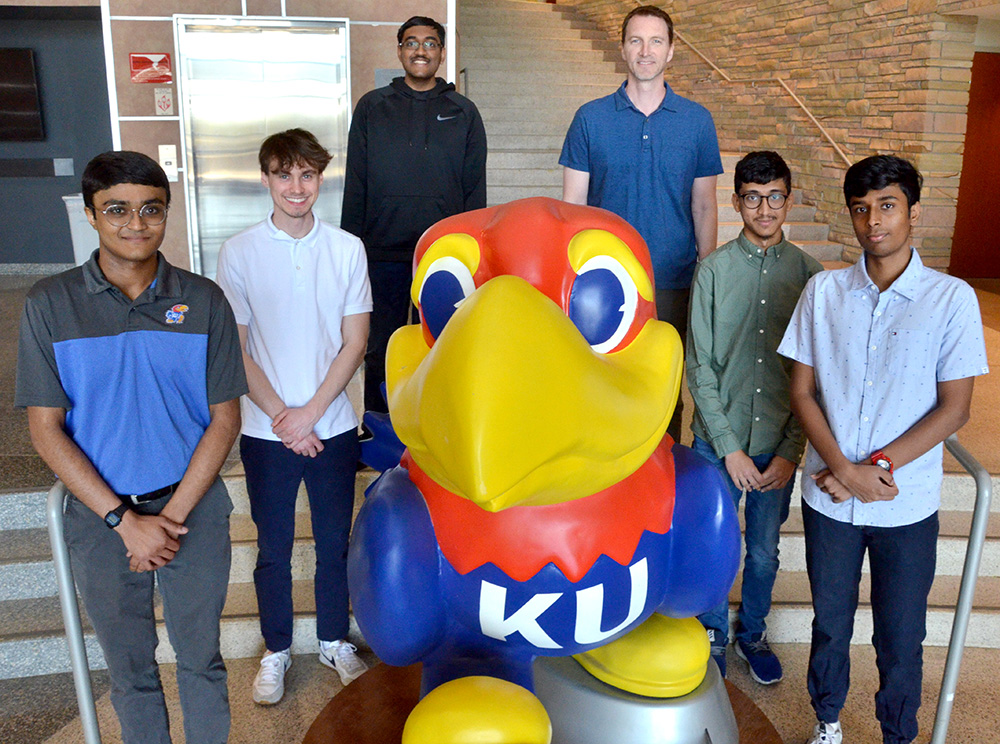KU Engineering students craft ‘Simulearn’ app to win KC Fed Code-A-Thon

LAWRENCE — Amazon Alexa, Google Home and Home Assistant all make it easy for users to turn on lights, track grocery lists, automate climate controls and handle other relatively mindless home tasks that take up time and attention.
Now, a group of University of Kansas engineering students has written an app to help anyone learn the actual computing language that could one day help people program their own devices.
And they did it all in 30 hours.
The five students, all sophomores in the Department of Electrical Engineering & Computer Science, created the app as part of this year’s Kansas City Fed Code-A-Thon, organized by the Kansas City Federal Reserve Bank. The team finished first among 18 teams from regional colleges who competed over two days to achieve a common goal: help someone learn code and use it in their everyday life.
KU’s team, called N.A.R.C.S. — a name comprising the first letter of the first name of team members Nikhil Raja, Abir Haque, Rahul Amatapu, Chase Burkdoll and Shad Ahmed Shahul Hameed — created an app to help people learn the Python computer programming language using smart home devices.
All five teammates already had struggled enough in their EECS classes — “trying to figure out how conditional statements and for-loops worked,” Haque said — so they were grateful that the announced-on-site theme would allow them to turn the challenge into an opportunity to build upon their collective passion for home automation technologies.
“We were also all friends walking into the competition,” Haque said. “We saw this as a great opportunity to learn about new technologies while hanging out as well.”
Last month’s competition started on a Friday night. Before they’d gone to sleep they’d brainstormed ideas, identified the app’s requirements and designed the solution. They spent Saturday developing and testing the app.
Using TypeScript, React and Git to craft the source code, N.A.R.C.S members had generated an app — dubbed Simulearn — that delivered a working prototype. Teams were judged in five categories: innovation, UX/polish, functionality, impact/potential and presentation.
Experience in the KU School of Engineering, Haque said, certainly prepped the N.A.R.C.S members for success.
“Every class we have taken so far — whether it be Software Engineering, Discrete Structures or a non-EECS class like Linear Algebra — places a great deal of emphasis on developing strong problem-solvers and team players,” said Haque, a student research assistant for the Institute for Information Sciences and an undergraduate research fellow. “In addition, KU does a great job at combining theory with application. These traits are extremely important.”
The KC Fed conducts the annual Code-A-Thon to encourage and inspire college students studying computer science and engineering. Nearly half of all KC Fed employees are information technology professionals.
“We look forward to competing next year,” Haque said. “Seeing that we are still sophomores, we hope to compete in similar competitions to broaden our skills and just have fun.”
Photo, from left to right: Abir Haque; Chase Burkdoll; Nikhil Raja; Erik Perrins, chair of the Department of Electrical Engineering and Computer Science; Shad Ahmed; Rahul Amatapu.